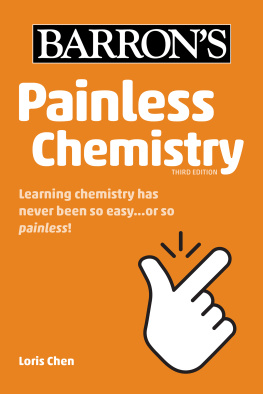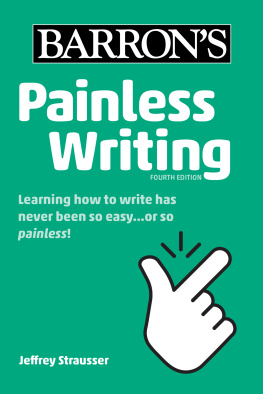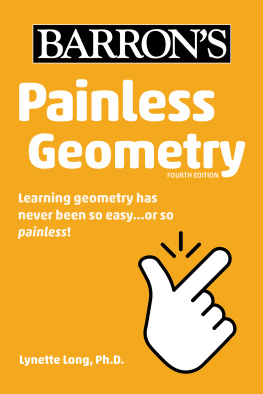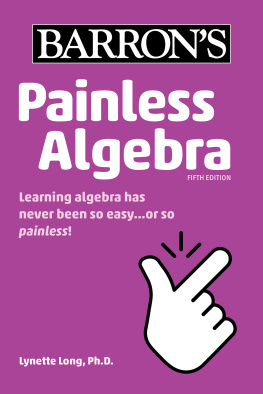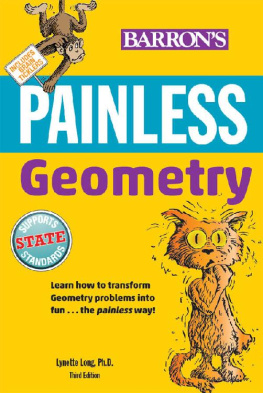Loris Chen - Painless Chemistry
Here you can read online Loris Chen - Painless Chemistry full text of the book (entire story) in english for free. Download pdf and epub, get meaning, cover and reviews about this ebook. year: 2020, publisher: Barrons Educational Series, genre: Children. Description of the work, (preface) as well as reviews are available. Best literature library LitArk.com created for fans of good reading and offers a wide selection of genres:
Romance novel
Science fiction
Adventure
Detective
Science
History
Home and family
Prose
Art
Politics
Computer
Non-fiction
Religion
Business
Children
Humor
Choose a favorite category and find really read worthwhile books. Enjoy immersion in the world of imagination, feel the emotions of the characters or learn something new for yourself, make an fascinating discovery.
- Book:Painless Chemistry
- Author:
- Publisher:Barrons Educational Series
- Genre:
- Year:2020
- Rating:4 / 5
- Favourites:Add to favourites
- Your mark:
- 80
- 1
- 2
- 3
- 4
- 5
Painless Chemistry: summary, description and annotation
We offer to read an annotation, description, summary or preface (depends on what the author of the book "Painless Chemistry" wrote himself). If you haven't found the necessary information about the book — write in the comments, we will try to find it.
Painless Chemistry — read online for free the complete book (whole text) full work
Below is the text of the book, divided by pages. System saving the place of the last page read, allows you to conveniently read the book "Painless Chemistry" online for free, without having to search again every time where you left off. Put a bookmark, and you can go to the page where you finished reading at any time.
Font size:
Interval:
Bookmark:

Dedication
This book is dedicated to my children, Jay and Tiffany, and the students who asked not What? but rather How? and Why?
Copyright 2021, 2016, 2011 by Kaplan, Inc.,
d/b/a Barrons Educational Series
All rights reserved under International and Pan-American Copyright Conventions. By payment of the required fees, you have been granted the non-exclusive, non-transferable right to access and read the text of this eBook on screen. No part of this text may be reproduced, transmitted, downloaded, decompiled, reverse engineered, or stored in or introduced into any information storage and retrieval system, in any form or by any means, whether electronic or mechanical, now known or hereinafter invented, without the express written permission of the publisher.
Published by Kaplan, Inc., d/b/a Barrons Educational Series
750 Third Avenue
New York, NY 10017
www.barronseduc.com
ISBN: 978-1-5062-6809-5
10 9 8 7 6 5 4 3 2 1
Kaplan, Inc., d/b/a Barrons Educational Series print books are available at special quantity discounts to use for sales promotions, employee premiums, or educational purposes. For more information or to purchase books, please call the Simon & Schuster special sales department at 866-506-1949.
From the food you eat to the air you breathe, chemistry is everywhereand its easy to understand... or at least it can be with the help of this book!
Whether you are learning chemistry for the first time, or you are trying to remember what youve learned but have forgotten, this book is for you. Each chapter of the book includes basic and advanced information for different learning levels and needs. Dont worry about memorizing the periodic table of the elements. Its a tool. Learn instead how to use it. Most of all, dont be afraid. Dive inits painless!
Painless Icons and Features
This book is designed with several unique features to help make learning chemistry easy.
 PAINLESS TIP
PAINLESS TIP
You will see Painless Tips throughout the book. These include helpful tips, hints, and strategies on the surrounding topics.
 CAUTIONMajor Mistake Territory!
CAUTIONMajor Mistake Territory!
Caution boxes will help you avoid common pitfalls or mistakes. Be sure to read them carefully.
 BRAIN TICKLERS
BRAIN TICKLERS
There are Brain Ticklers throughout each chapter in the book. These quizzes are designed to make sure you understand what youve just learned and to test your progress as you move forward in the chapter. Complete all the Brain Ticklers and check your answers. If you get any wrong, make sure to go back and review the topics associated with the questions you missed.
ILLUSTRATIONS
Painless Chemistry is full of illustrations to help you better understand chemistry topics. Youll find tables, graphs, charts, and instructive science illustrations to help you along the way.
SIDEBARS
These shaded boxes contain extra information that relates to the surrounding topics. Sidebars can include more advanced topics, detailed examples, and more to help keep chemistry interesting and painless.
Chemistry is the division of physical science that studies the composition, properties, and reactions of substances. The nature of matter and energy have been investigated and debated from ancient times.
Our universe is composed of energy and matter. Energy is the ability to do work. In chemical reactions, chemical energy is interconverted with other types of energy, such as light, heat, and electricity.
Matter has mass and inertia. Matter also takes up space (volume). The amount of matter in a specified space is density. For pure substances, density at a specific pressure and temperature is an identifying characteristic of the substance.
Mass is the amount of matter in an object. The basic unit of mass is the kilogram. One gram is the approximate mass of a 5-cm (2-inch) steel paper clip. A kilogram is 1,000 grams (2.2 pounds). One liter of water has a mass of 1 kilogram.
Common tools for measuring mass are the double pan balance, triple beam balance, and electronic balance. The double pan balance compares the mass of a substance to a known standard mass (a metric weight). The triple beam balance has an arm with sliding mass units that are adjusted to balance the mass of a substance. The electronic balance provides a digital measurement of the mass of a substance.
Mass versus weight
Weight is a measure of the pull or acceleration of gravity on an objects mass (w = mg, or weight equals mass times the acceleration of gravity). The acceleration of gravity near Earths surface is 9.8 m/sec2. The weight of an object can change if gravity changes. The amount of matter in an object does not change even if the pull of gravity changes. Therefore, the mass of an object does not change even if the pull of gravity changes.
In many countries, the kilogram (kg) is commonly used to express weight. In science, kilogram is a metric unit of mass. The newton is a metric unit of weight, and is defined as the force needed to accelerate 1 kilogram of mass at a rate of 1 meter per second per second. One newton equals 1 kg m/sec2. Another unit of force is the pound. One pound of force is about 4 newtons.
Sometimes in chemistry the term weight is used when mass is meant. Be careful to pay attention to units of measure.
 PAINLESS TIP
PAINLESS TIP
Mass and Weight
Mass is the amount of matter in a substance.
The basic metric unit of mass is the kilogram.
Weight is the pull of gravity on an object.
The basic metric unit of weight is the newton.
On Earth 1 kilogram exerts a force of 9.8 newtons.
 BRAIN TICKLERSSet # 1
BRAIN TICKLERSSet # 1

1.What is the total mass of the marbles shown in the illustration?
2.If each of the 10 glass marbles on the scale has the same mass, what is the average mass of a single marble? Show your calculation.
3.A brass plate has a mass of 2 kilograms on Earth. The gravity of the moon is one-sixth that of Earths gravity. What is the mass of the brass plate on the moon? Explain your answer.
(Answers are on .)
Volume is the space that matter occupies or takes up. Volume is measured in three dimensions: length, width, and height. A common tool for measuring the volume of a regularly shaped solid is the metric ruler or meter stick. Common units of measure for solids are cubic centimeters (cm3) and cubic meters (m3).
A common tool for measuring liquid volume is the graduated cylinder. The volume is measured at the bottom of the meniscus, or curve of the liquid in the cylinder. Common measures of liquid volume are the milliliter (ml) and liter (l). One milliliter is equal to 1 cubic centimeter (cm3). A liter is 0.26 gallons, or a little more than a quart.
Font size:
Interval:
Bookmark:
Similar books «Painless Chemistry»
Look at similar books to Painless Chemistry. We have selected literature similar in name and meaning in the hope of providing readers with more options to find new, interesting, not yet read works.
Discussion, reviews of the book Painless Chemistry and just readers' own opinions. Leave your comments, write what you think about the work, its meaning or the main characters. Specify what exactly you liked and what you didn't like, and why you think so.

